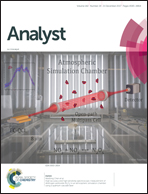Reversion of gold nanoparticle aggregates for the detection of Cu2+ and its application in immunoassays†
Abstract
A high concentration of copper is a hazardous element to organisms and human health. Although various strategies have been reported for the sensitive detection of copper, a facile and rapid detection of aqueous copper has seldom been addressed to date. Here, we present an easy and accessible colorimetric method to detect Cu2+ using the redispersion of cysteamine-modified gold nanoparticles (CA-AuNPs). Initially, CA caused the aggregation of AuNPs due to the electrostatic interaction and aggregated AuNPs can be regenerated in basic medium. The subsequent addition of Cu2+ to the CA-AuNP dispersion could effectively trigger the aggregation of CA-AuNPs, resulting from the coordination reactivity between the deprotonated CA and Cu2+. This strategy resulted in a detection limit (LOD) of 1.52 μM in drinking water, which is below the U.S. Environmental Protection Agency permissible limit (20 μM). To demonstrate the broad application of CA-AuNPs, we further applied this method to plasmonic immunoassays based on the competitive interaction of Cu2+ between CA-AuNPs and enzymes. The LOD of the Down syndrome biomarker hyperglycosylated human chorionic gonadotropin (H-hCG) was 0.125 mIU mL−1, which is better than that of commercial immunoassays. Importantly, the determination of H-hCG in serum indicates its applicability for the measurement of real samples. Our assay agrees well with the current immunoassay systems and thus it can easily be expanded to a more common sensing platform for different types of biotargets by changing the corresponding antibodies.



 Please wait while we load your content...
Please wait while we load your content...